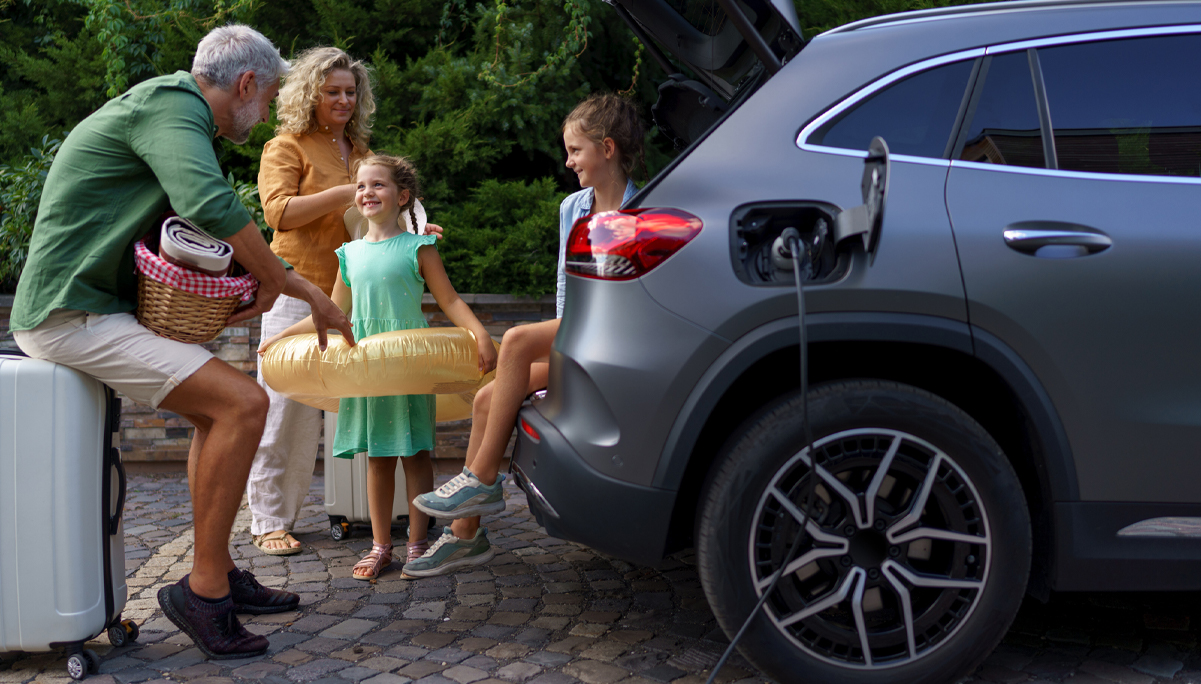
Give your apartment block the wow factor with a sustainability upgrade
10 July 2023
How the switch to electric is changing the way we buy cars
7 August 2023The greenest holiday travel option revealed
Planes, trains, or automobiles? Ever wondered what the greenest travel option for your holidays is?
With the climate crisis making sustainability a top priority, green travel choices are becoming as important as remembering to pack your toothbrush. In fact, Aviva’s How We Live report found that 64% of British holidaymakers are seeking out green travel options.
Transport accounts for almost one quarter of the UK’s carbon emissions. It’s the reason why the government is phasing out petrol and diesel cars and backing the switch to electric.
With all that in mind, here’s a look at how green (or not) four different travel options are, to help you make an informed choice and plan a guilt-free getaway.
But first…
How we compare green travel options
Comparing the carbon footprint of different travel options can get complicated quickly.
Take a petrol car, for example.
There are a ton of variables that affect how much it pollutes.
If you’re a boy or girl racer, your driving style will be much less efficient than a hypermiling obsessive (yep, it’s a new one to us too).
The number of passengers and how many kitchen sinks you’ve packed come into play too, because a heavier car burns more fuel.
And then you have a host of other factors. Aerodynamics (who knew that open windows can reduce fuel efficiency by up to 20%?), traffic levels, and tyre choice to name just a few.
So, to keep things manageable, we’ll make some assumptions and use average figures.
The idea, after all, is to help you decide on the greenest option, not get nerdy about drag co-efficients and tyre rolling resistance.
Carbon footprint per passenger
We’ll also use carbon footprint per passenger figures. This gets important when we’re comparing the impact of public transport options.
Take a train, for example. Because it holds significantly more people than a car, it would be unfair to attribute the carbon footprint of the entire train to just one passenger. The same goes for aeroplanes.
The data we’ll use takes the total carbon footprint of the journey and divides it by an average number of passengers.
The data on green travel options
Like we said, calculating an accurate carbon footprint can get messy.
We’ll turn to the experts and use figures published by Our World in Data, a team of data scientists led by Dr Max Roser of the University of Oxford.
Which travel option is the greenest?
OK, preamble over. Let’s get to the juice: which travel option is the greenest?
We’ll pitch an aeroplane, a train, a petrol car, and an electric car against each other to see which has the lowest carbon footprint on a journey from London to Edinburgh, a trip of about 400 miles.
First up, let’s take to the sky.
The aeroplane
Most people know aeroplanes are bad for the environment, but just how bad are they?
According to the data, a domestic flight releases about 408g CO2e per mile per passenger.
CO2e stands for carbon dioxide equivalent. It’s a measurement that factors in all the greenhouse gases (not just carbon) created by an activity. It’s the standard unit scientists use.
408g CO2e per mile on our trip to Edinburgh totals about 163kg CO2e. And that doesn’t even include the drive to and from the airport at each end.
London to Edinburgh carbon footprint
Aeroplane: 163kg CO2e
The petrol car
In the not-too-distant future petrol cars will become museum pieces, like steam engines and penny farthings. But for now, they’re still the most common type of car on the road.
They’re about 25% less harmful than an aeroplane, at 307g CO2e per mile per passenger. Better, but still not great.
On our 400 mile trip, it’s just over 122kg CO2e.
London to Edinburgh carbon footprint
Petrol car: 122kg CO2e
The train
Now we’re getting into the greener options. Trains are very efficient and can carry a lot of people.
The data shows a typical UK train produces about 65g CO2e per mile per passenger. That’s about six times less than flying and five times less than driving a petrol car.
It works out at about 26kg CO2e for our highland jaunt.
London to Edinburgh carbon footprint
Train: 26kg CO2e
The electric car
Electric cars are the new kids on the block and there’s no doubt they produce fewer harmful emissions than their petrol equivalents. There’s a carbon footprint created when they’re manufactured, but driving them releases zero emissions from the exhaust. In fact, they don’t even have an exhaust, because they’re not burning anything.
It’s important to note that how you charge your car affects its carbon footprint.
The data estimates that an electric car charged using UK grid electricity produces about 84g CO2e per mile per passenger.
84g CO2e per mile gets you from London to Edinburgh for 33kg CO2e.
But if you can charge your car using 100% solar energy – say you’ve got a home EV chargepoint combined with solar panels – your CO2e will be a big fat 0g.
Realistically, on a long journey, you’re likely to need to charge from the grid at some point. But if you’re able to meet a chunk of your EV charging needs with solar, you’ll minimise your impact on the environment, and save money to boot.
London to Edinburgh carbon footprint
Electric car: 33kg CO2e if you charge using the mains, much less if you’re able to fuel some of the journey with solar power.
The conclusion
Well, the results are in.
The train and the electric car are by far the greenest options. The petrol car and the aeroplane have lived up to their reputations as the worst polluters.
If you charge your electric car using mains electricity, the train likely wins. But if you can charge up with solar, the electric car starts vying for the #1 spot.
It would be a tall order to power the entire journey using solar-generated electricity. A 45kWh Volkswagen ID3, for example, has a 200-mile range. Leave with a full battery and you might get away with one top-up at a public EV chargepoint.
If you’ve got solar panels and a home EV charger, you could fuel your first 200 miles with solar. That would wipe out the carbon footprint from half your journey, leaving you with a total of 16.5kg CO2e.
That’s potentially a whopping 10 times better than an aeroplane.
About Powerverse
We’re industry experts in home energy management. Our easy-to-use app is built for your future electric home. It will effortlessly sync your solar, battery, heat pump, EV charger and more, helping you cut costs and your carbon footprint on your way to becoming energy-independent. Curious to know more? Talk to one of our experts.
Also, if you’re considering installing solar panels, we’d be more than happy to recommend several trusted partners who can provide and install them for you.

